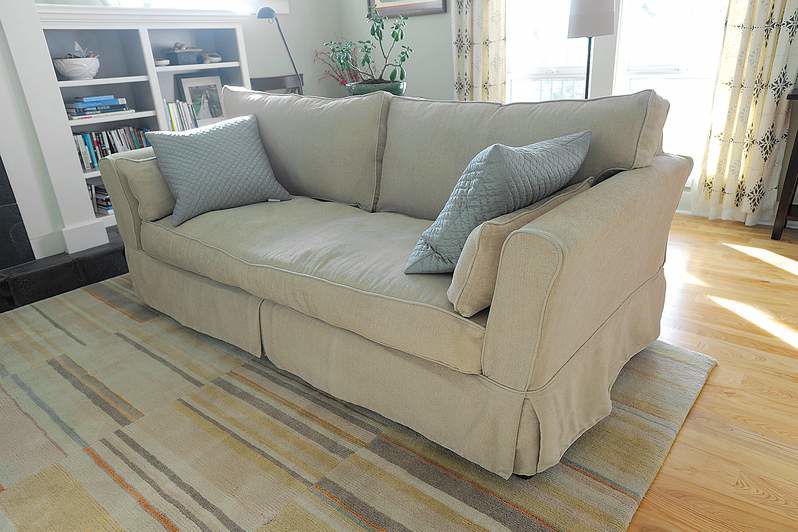Slipcovers can update furniture
Published 4:00 am Tuesday, March 8, 2011

- This sofa was designed to include a washable slipcover to protect the furniture from wear and dirt.
Slipcovers are versatile and kind of magical. They can transform the look of an old sofa or chair, protect new furniture from kids and pets, or unify the look of a room.
Slipcovers can also be an economical alternative to buying new furniture.
Trending
Even though such covers are not a hot trend in home design right now, Bend interior designer and home staging specialist Jacquie Sebulsky said the slipcovered look — fitted covers for furniture — never goes out of style.
“Slipcovers were really trendy 10 years ago, and then design went to a cleaner, sleeker, more modern look and didn’t incorporate slipcovers so much, but I think slipcovers are really classic,” Sebulsky said.
Keep in mind, though, that slipcovers always create a relaxed and casual look.
“If you don’t like it, if you like things tailored, you’re going to have a hard time falling in love with slipcovers,” Sebulsky said.
She noted that slipcovers originated in the United States on the East Coast, places such as the Hamptons of Long Island, N.Y., and the late 19th-century mansions of Providence, R.I.
“Those fantastic old houses would always have slipcovers to protect furniture from weather and light, and they didn’t want the kids to ruin the furniture. It was that white cotton duck cloth. Those great old houses still use that look as a classic design element, and that filters to other parts of the country,” Sebulsky said.
Trending
You may want to consider slipcovers the next time you notice your furniture needs to be freshened up. It can be a cost-effective way to get a whole new look.
Ready-made or custom
Slipcovers can be purchased ready-made from a variety of sources: big-box home and department stores, furniture stores and online companies, to name a few.
Ready-made is the most inexpensive option, often costing less than $100 for a couch slipcover, with standard sizes (small, medium and large), and a limited choice of fabrics and colors.
The downside of ready-made slipcovers, said Sebulsky, is they need to be adjusted often since they have a loose fit. Some have ties that need to be re-tied frequently, and they have to be tucked in repeatedly.
“You’ll always be fussing with them. They’ll look like a shirt that’s not quite tucked in if you use your sofa heavily,” she said.
Upholsterers and seamstresses can create a perfectly fitted custom slipcover for a couch, love seat, recliner, dining chair or ottoman. The skill and time involved are reflected in the price.
Karen Johnson of KJ’s Upholstery in Bend estimated the cost of a custom slipcover for a sofa, including fabric, would run about $700, depending on the style and details.
Johnson said that sometimes slipcovers are a great option, other times not.
“If it’s an older piece of furniture, you have padding that’s been compressed over the years. If you reupholster instead, I can put in a new layer of padding and give the piece more comfort. I try to make sure that someone who wants a slipcover understands the pros and cons,” Johnson said.
If you have a sofa you like, but it’s out of style or wearing out, check with the manufacturer to see if slipcovers are available.
“Most companies keep a pattern on file even if the sofa has been discontinued. You can pick new fabric and they’ll make a slipcover for you. It’ll typically cost about $600 to $1,000, or half of what a new sofa would cost,” said Sebulsky.
Styles, fabrics, colors
Slipcovers come in a multitude of styles, from country to modern. Some are draped and tucked, others have piping or ruffles, some have tailored pleats.
Sebulsky suggested browsing the Internet to see which styles appeal to you. She said that Cottage Living and Southern Living magazines often show the slipcovered look in their home design articles.
As for fabrics and colors, Sebulsky said the trend now is for more natural and organic textures and hues, so if you want a modern look, lean toward neutral colors and cotton and linen fabrics, not synthetics.
One of the big pluses of slipcovers is the majority of them are machine washable.
“That’s a big deal. If you invest in a good piece of furniture, you can protect it for a long time,” said Sebulsky.
A laundromat washing machine works best for a large slipcover that has many yards of fabric.
After washing, Sebulsky recommends fluffing it in a dryer set on low heat or no heat for a short amount of time to release some of the wrinkles, and then putting it back on the sofa while it’s still damp. If washing caused a bit of shrinkage, the fabric will stretch a bit when it’s damp, and, as it dries, you’ll get a tighter fit. You can steam it later with an iron or steamer if wrinkles bother you.
Besides changing a look and protecting furniture from dirt, slipcovers can unify a room full of mismatched furniture.
For an inexpensive fix, buy matching ready-made neutral slipcovers for a sofa and chair that clash, and use pillows to add interest and color.
For a higher-end look, Sebulsky suggested checking out fabric stores for relatively inexpensive designer fabric remnants. Such fabrics can make great looking custom slipcovers crafted by an upholsterer or sewing pro.
If your furniture looks tired but still has a lot of function left, the slipcover is an old concept that can make a room look fresh and new.







